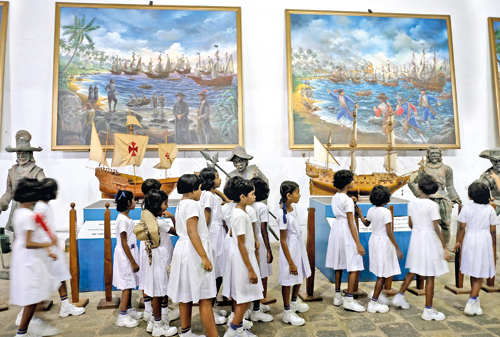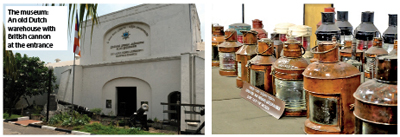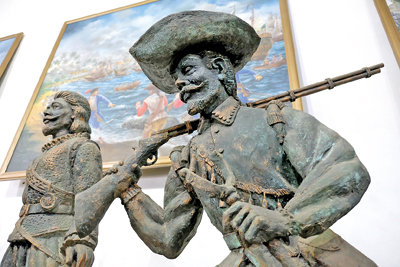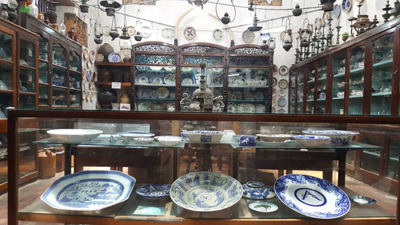Across the seas to a distant past
Several British cannon stand imperially, at the entrance to the Sri Lanka Ports Authority Maritime Museum on Chaithya Road, adjoining the Colombo Port. A lesser-known attraction of Colombo, now onto its 15th year, the museum, housed in an old Dutch warehouse is dedicated to the history and evolution of the ports of the island. Maintained by the Sri Lanka Ports Authority, the museum opened during the war years (2003) and being located at a one time ‘high security zone’ with restricted public access is somewhat of a ‘forgotten attraction’.

Schoolchildren visiting the museum and below (right), a row of old navigation lamps. Pix by Amila Gamage
An innovative concept which deserves credit, the museum, however, is in need of rehabilitation if it is to be a tourist attraction and a place of learning and research. The only remaining Dutch building of the Colombo Port area today, the warehouse or pakhuis has a distinctive ‘barrel roof’. The building, Assistant Manager, Communication and Public Relations, Sri Lanka Ports Authority, Kavya Indrajith says, has been refurbished to accommodate the exhibits and paintings, while retaining its original character.
A grant by the Netherlands Government under their colonial heritage conservation programme had been given for this purpose, he says. “The museum which comes under the purview of the welfare division of the Ports Authority is a social welfare project. No admission fee is charged from the public – local or foreign.”
 The ground floor with some of its original floor tiles still visible, exhibits the arrival of Prince Vijaya in visual form. Several paintings of the arrival of Theri Sangamitta, Ibn Batuta and the Portuguese, Dutch and British, speaking for the international relations – both cordial and hostile, facilitated by the local ports, adorn its solid brick walls. The shipwrecks and the goods recovered from them, coins and much more are cited as living sources which speak for the position the island enjoyed as a trade hub. The paintings depicting the Colombo Port from the early days to British times offer interesting visuals. The upper floor of the building is a photo gallery of the modern Colombo Port with portraits of some of the Port’s notable administrators.
The ground floor with some of its original floor tiles still visible, exhibits the arrival of Prince Vijaya in visual form. Several paintings of the arrival of Theri Sangamitta, Ibn Batuta and the Portuguese, Dutch and British, speaking for the international relations – both cordial and hostile, facilitated by the local ports, adorn its solid brick walls. The shipwrecks and the goods recovered from them, coins and much more are cited as living sources which speak for the position the island enjoyed as a trade hub. The paintings depicting the Colombo Port from the early days to British times offer interesting visuals. The upper floor of the building is a photo gallery of the modern Colombo Port with portraits of some of the Port’s notable administrators.
History has it that this Dutch warehouse had once been a store for various types of cured meat, butter, cheese, gin and other foods which came from overseas. Dr. R.L. Brohier notes in his work, Changing Face of Colombo, that these warehouses were also used to store the cinnamon delivered from ‘circumjacent tracts and the other spices which were shipped to Amsterdam, the timber and barrels of arrack which went to Batavia, the arecanut and black sugar or ‘juggary’, for ports on the Malabar and Coromandel coasts.’

Models of Naval captains of the past
The buildings of Portuguese origin in Colombo were demolished for the purpose of rebuilding of the fortified city immediately by the Dutch. The demolition process however, got delayed awaiting the sanction of the Board of Directors of the Dutch East India Company in Amsterdam, as Prof. K.D. Paranavitana, the Dutch authority in the country explains, “The plan of Colombo prepared by Surveyor Jan Christiaen Toorzee in 1697 included this building for the first time in his plan. Based on the maps and plans produced during the ensuing century the location and the architectural features remained unchanged until 1787, the tail end of the Dutch administration.” The building survived even though considerable changes had taken place during the British administration. “We are fortunate to have this heritage building preserved for posterity,” he notes.
If properly revamped, the Maritime Museum could well be a highlight among Colombo’s colonial legacies.
The museum is open to the public from 9 a.m. to 4 p.m. on all days except on public holidays.
| Historic Mansion and one man’s love for all things old | |
| By Musaffa Mafaz  A valuable collection Housed in a colonial Dutch house along Leyn Baan Street in Galle Fort is one of the largest private museums in the country. Known as the ‘Historic Mansion’, the museum was set up by M.H.A. Gaffar and is currently run by his son Kamal Hussain. The state of the building when it was bought in 1982 by Mr. Gaffar, depicted in several photographs showcased at the museum, tell of a long labour of love to restore it. Under the guidance of the Department of Archaeology, the building was painstakingly reconstructed and opened as a museum in 1991 by then President Ranasinghe Premadasa. Antiques from centuries past even before the Portuguese, Dutch and British eras can be seen in the museum. A leading businessman dealing in gems and jewellery, Mr. Gaffar’s lifelong interest in all things old led him to collect souvenirs and artefacts. Whenever he visited countries abroad, he explored many museums adding to his knowledge and of course motivating him to open his own museum. Now his museum houses his collection of over 50 years.  The pretty courtyard Visitors can browse through documents of the Kandyan Convention, peer at ancient plates, glass bottles, jewellery, weapons, medical equipment, books, furniture and historic items found in the sea all displayed along with old chests, textiles, lamps, rare gemstones and rocks and many more. In the centre of the museum is a small beautiful courtyard, a feature of Dutch houses of old. The well found there believed to be more than 300 years old has pure water. A stone slab with an engraved sign of the East India Trading Company can be seen near the well. A gem shop is also based in the museum and visitors can observe a gem cutter who has worked at the museum for over 15 years. They can also see the process of making ‘beeralu lace’ a cottage industry introduced by the Portuguese. The museum is open to the public free of charge every day. |


